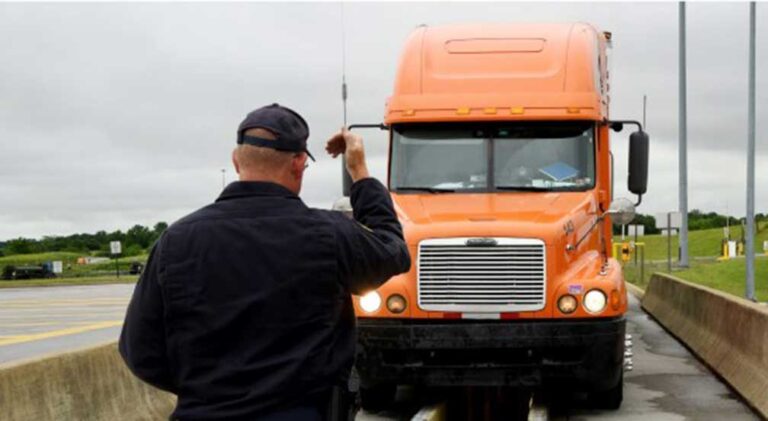Commercial motor vehicle enforcement personnel in Canada, Mexico and the U.S. conducted 48,761 inspections during this year’s International Roadcheck, which took place May 14-16.
According to the Commercial Vehicle Safety Alliance (CVSA), 77% of commercial motor vehicles and 95.2% of commercial motor vehicle drivers did not have any out-of-service (OOS) violations.
Conversely, inspectors discovered 13,567 vehicle, 2,714 driver and 163 hazardous materials/dangerous goods (HM/DG) out-of-service violations, and placed 9,345 commercial motor vehicle combinations and 2,290 drivers out of service. The total overall vehicle out-of-service rate was 23%, and the driver out-of-service rate was 4.8%.
“International Roadcheck is a three-day commercial motor vehicle and driver inspection, enforcement and data-gathering initiative,” the CVSA said in the report. “Law enforcement jurisdictions throughout North America voluntarily participate in International Roadcheck with support from the Federal Motor Carrier Safety Administration, Canadian Council of Motor Transport Administrators, Transport Canada, and Mexico’s Ministry of Infrastructure, Communications and Transportation.”
Vehicle Violations
North American Standard Level I, II and V Inspections are the inspection types that involve inspections of commercial motor vehicles. Of the 40,458 Level I, II and V Inspections conducted, 9,299 vehicles combinations were placed out of service, which means those vehicle combinations were restricted from further travel until all out-of-service vehicle violations were resolved. A vehicle is placed out of service when an inspector identifies critical vehicle inspection item violations, as detailed in the CVSA’s North American Standard Out-of-Service Criteria.
“The top vehicle out-of-service violation in North America was for defective service brakes,” the CVSA said. “Fully functional brakes are essential, as the ability to control a vehicle’s speed and make a quick stop, if necessary, is vital to safe driving. Defective service brakes can prevent a driver from stopping quickly and/or completely. When brakes fail, the results can be catastrophic, not only for the driver, but for everyone on our roadways.”
CVSA aims to prevent crashes caused by faulty braking systems through Operation Airbrake, a comprehensive program dedicated to improving commercial motor vehicle brake safety throughout North America. This is achieved by conducting roadside inspections and educating drivers, mechanics, owner-operators and others on the importance of proper brake inspection, maintenance and operation.
VSA Decals
Commercial motor vehicles without critical inspection item violations on the vehicle after a Level I or V Inspection are eligible to receive a CVSA decal. Inspectors affixed 17,395 decals to power units, trailers and motorcoaches/buses during International Roadcheck. The decals are valid for the month of issuance, plus two additional months. Vehicles displaying a valid CVSA decal typically are not subject to re-inspection during that time. However, nothing prevents re-inspection of a vehicle or combination of vehicles bearing valid CVSA decals.
Vehicle Emphasis Area
Each year, International Roadcheck places special emphasis on a category of vehicle violations and a category of driver violations, according to the CVSA. The vehicle emphasis area this year was on tractor protection systems (TPS), including the tractor protection valve, trailer supply valve and anti-bleed-back valve. Inspectors identified 564 TPS-related violations on commercial motor vehicle combinations. Tractor protection systems safeguard the tractor’s air supply and prevent air loss when the tractor is not connected to a trailer or if the trailer breaks away.
Driver Violations
“North American Standard Level I, II and III Inspections involve inspection of the operators of commercial motor vehicles,” the CVSA said. “Of the 47,743 Level I, II and III Inspections, inspectors restricted 2,290 commercial motor vehicle drivers from further travel due to driver out-of-service violations.”
Hours-of-service violations was the top reason drivers were placed out of service. Inspectors restricted 870 drivers from further travel due to hours-of-service violations. Hours-of-service regulations state the maximum amount of time commercial motor vehicle drivers are permitted to be on duty, including driving time, and specify the number and length of rest periods. These regulations are in place to prevent crashes caused by driver fatigue; to protect drivers’ quality of life, health and wellbeing; and to ensure road safety.
Driver Emphasis Area
The driver emphasis area this year was on alcohol and controlled-substance possession, according to the CVSA. Inspectors issued 78 drug and 26 alcohol possession/use out-of-service violations throughout North America during International Roadcheck.
In the U.S., inspectors identified 63 drivers who were placed out of service for operating vehicles even though they were listed in the FMCSA’s Drug and Alcohol Clearinghouse, an online government database that identifies drivers who are prohibited from operating a commercial motor vehicle based on drug and alcohol program violations and ensures that such drivers receive the required evaluation and treatment before operating a commercial motor vehicle on our roadways.
Safety Belt Usage
“Another driver violation that was captured during International Roadcheck was safety belt usage,” the CVSA said. “A total of 535 safety belt violations were issued during this year’s International Roadcheck. According to FMCSA, 14% of commercial motor vehicle drivers do not wear their safety belt. The agency intends to conduct an online survey of commercial motor vehicle drivers to understand their perceptions and behaviors regarding safety belt usage and road safety.”
Hazardous Materials/Dangerous Goods Violations
In North America, there were 163 HM/DG out-of-service violations during the 72 hours of International Roadcheck. The top out-of-service violation was for loading. Loading regulations are in place to ensure the safety of the public and those who prepare, inspect and transport HM/DG.
Inspection Levels
Inspectors conducted 48,761 Level I, II, III and V Inspections total during the three days of International Roadcheck. Broken out, that was:
- 29,342 Level I Inspections – The Level I Inspection is a 37-step procedure that checks the driver’s operating credentials and the vehicle’s components.
- 10,098 Level II Inspections – A Level II Inspection is a walk-around driver/vehicle inspection that includes all the items that can be inspected without the inspector physically getting under the vehicle.
- 8,303 Level III Inspections – The Level III Inspection is an inspection of the driver’s credentials, status in the Drug and Alcohol Clearinghouse, and hours-of-service records.
- 1,018 Level V Inspections – The Level V Inspection is a vehicle-only inspection that includes each of the vehicle inspection items. The driver does not need to be present for this inspection level.
The Level I Inspection is the most-commonly performed inspection, not only during International Roadcheck, but throughout the year; however, inspectors may opt to conduct any of the other inspection levels instead.
In all, there are eight inspection level types, which range from the strict inspection of radioactive materials by a specially certified inspector to electronic inspections that can be conducted while the vehicle is motion without direct interaction with an enforcement officer.
U.S.
CVSA-certified inspectors performed 42,332 inspections in the U.S. during the three days of International Roadcheck. Broken out, 24,232 Level I Inspections, 9,955 Level II Inspections and 8,145 Level III Inspections were conducted. Inspectors identified 11,675 vehicle, 2,619 driver and 140 hazmat violations and placed 7,930 vehicle combinations and 2,151 drivers out of service. The vehicle out-of-service rate was 23.2% and the driver out-of-service rate was 5.1%. The top vehicle violation was for defective brakes (3,093). The top driver violation was hours of service (845). Loading was the top hazmat violation (60).
Canada
A total of 5,411 inspections were conducted May 14-16 in Canada. Specifically, 5,110 Level I Inspections, 143 Level II Inspections and 158 Level III Inspections were completed. Inspectors identified 1,798 vehicle, 102 driver and 23 dangerous goods out-of-service violations.
Mexico
Inspectors in Mexico conducted 1,018 Level V Inspections, which are vehicle-only inspections. They identified 94 out-of-service violations and placed 36 vehicles out of service, which is a 3.5% vehicle out-of-service rate. The top vehicle violation in Mexico during the three days of International Roadcheck was for tires, with 32 out-of-service violations. Tires provide stability and control on the road. Tires with sufficient tread depth and proper inflation reduce the risk of skidding, hydroplaning, and losing control in wet or slippery conditions. Worn or underinflated tires are more likely to blow out or lose traction, which can lead to dangerous situations on the road.








